In ancient times any work depended solely on human and animal power. From time to time several types of heavy construction equipment have been developed, which not only reduces human effort but also time. Each project involves cutting the earth, filling the earth, compacting, moving the earth, lifting the excavated earth, and moving a variety of construction materials from one place to another. If the above work quantity is huge, then huge construction machinery and other heavy equipment is required to consume less time and money. In this article, we will discuss the different types of heavy equipment used in construction work.

List of Heavy Construction Equipment
1. Tractor
2. Bulldozer
3. Grader
4. Scraper
5. Dragline
6. Clam Shell
7. Backhoe
8. Dumper Trucks
9. Road Roller
10. Sheep Foot Roller
11. Electric Overhead Crane
12. Belt Conveyor
13. Single Cable Rope Way
14. Tower Crane
15. Concrete Mixer
16. Pump Crete
17. Concrete Vibrator
1. Tractor
A tractor is a machine that is used for multiple purposes like hauling, moving earth, transporting materials, etc. The tractor is not only used for construction purposes, but also for agricultural, and mining fields. Generally, there are two types of tractors. One is a wheeled tractor other is a crawler tractor.
In case of light and speedy jobs wheeled tractor is used. On the other hand, a crawler tractor is generally used for heavy-duty. But the movement of a crawler tractor is comparatively lower than a wheeled tractor.
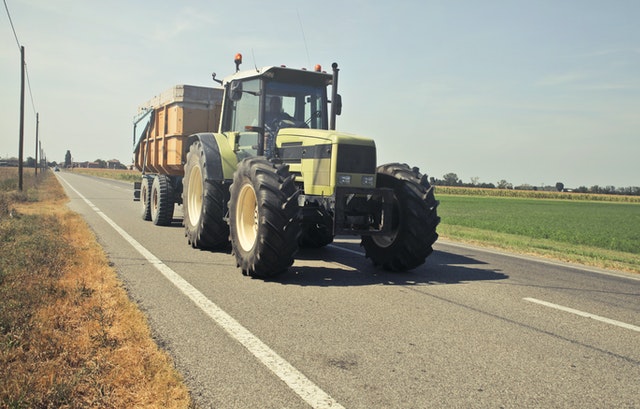
2. Bulldozer
The bulldozer is one of the most important heavy construction equipment mostly used in the construction field. It is mostly used to push any objects from their current position. Although, it is a multipurpose machine and can perform a number of operations. Dozers may be angle dozers, tree dozers, tilt dozers, and pus dozers.
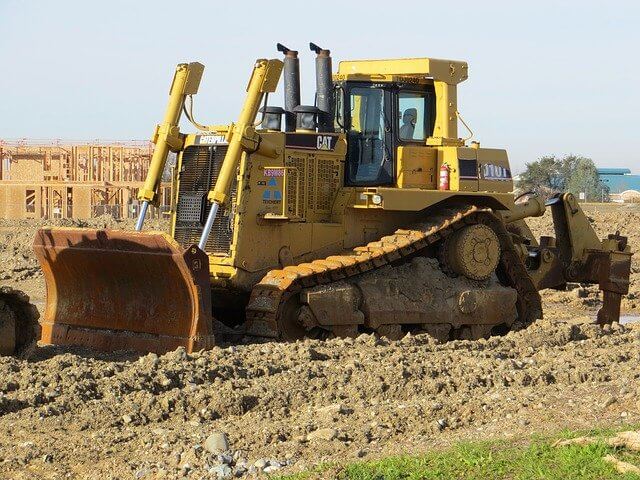
Generally, the price of a bulldozer varies from country to country. In the case of the USA and UK, the price of a single bulldozer varies from $25,000 to $250,000. The price depends on the capacity and power of the machine. The most commonly purchased model’s price is around $ 70,000 to $145,000.
3. Grader
Graders are also known as motor graders or road graders. The Grader is one of the most important machines mostly used in road construction projects. It is used to level the ground surface on which road is to be constructed. It has a blade below the framework as shown in fig.
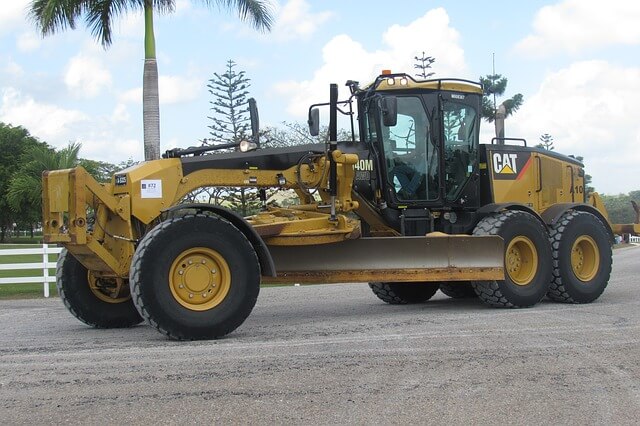
This blade can be lowered, tilted, or rotated as required. Grader is also used to remove snow from any existing roads. Scarifier, elevator, and roller are the other attachment that can be used by this machine. The grader may be classified as a towed grader or a motorized grader.
Towed grader is a small size grade that is drawn with a tractor. On the other hand, a motor grader is a fast-moving and self-propulsive machine. Usually, the speed of a motor grader is around 15 to 40 km/h, with a horsepower range from 90 to 300 H.P.
Read Also: Suitability of Various Compaction Equipment
4. Scraper
This construction equipment consists of a large bucket called scraper. This bucket is attached to a tractor. The scraper is one such type of equipment that can dig, load, haul, and discharge the soil or other construction materials in a uniform layer. The wheels of this machine do some compaction work also.
During discharging the materials, it keeps moving at a constant speed, and thus the soil is also spread automatically and uniformly. This machine is huge in size and thus requires more area to operate. For this reason, it is not possible to use for the small size of the workplace.
The scraper bowl or bucket has a cutting edge or blade at its button and it is able to dig the earth to a depth of around 25 cm.

Scrapers may be available in the following types.
⇒ Crawler drawn Scraper.
⇒ Two axle scraper.
⇒ Three axle scraper
5. Dragline
Dragline is another type of heavy construction equipment mostly used for digging the earth in a large depth or below the ground level. It consists of a long boom and a bucket. The bucket which is the digging tool is suspended from the boom ends with the help of a cable.

When there is a need to remove soil or debris from a larger depth, this machine will be the best choice for this work. This machine can perform its work even if it is not close to the pit because it has a long reach due to its boom.
There are three types of dragline, these are –
A. Crawler mounted: – The speed of this type of dragline is very low but can perform on soft ground, and is suitable for a large project.
B. Wheel-mounted: – In this type of dragline, travel speed is high and suitable for firm ground.
C. Truck-mounted: – It has a high travel speed. This machine is suitable for fir ground and scattered jobs.
This construction equipment is very useful for digging the canal bed, clearing ditches, making very high embankments, etc.
6. Clamshell
The clamshell is nothing but an excavator, which is generally used for digging earth above or below the ground level. This machine is suitable only for soft to medium-hard soil. It consists of a bucket, a boom, and a travel unit. Bucket which is loosely attached at the end of the boom with the help of a cable. This bucket can be lowered or lifted vertically with the help of the cable.
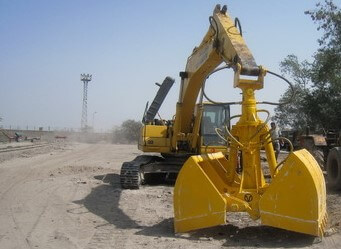
It does not have any drag cable but only a set of closing line and a set of hoist line. In this machine, the bucket consists of two halves, which are hinged together at the top and provided with sharp teeth at the lower end.
During the digging and filling operation, the bucket is allowed to reach on the top of the materials which are to be dug. Then bucket is lowered with shells open over the materials and then closing the shells by using the closing line. The bucket is then hoisted and swung to the position of dumping and the materials are dropped.
It can be used for moving large size of boulders from their current position. It is also preferred for jobs where perfect dumping is required. It is a very useful construction machine where the space limit is restricted like excavating foundation trenches, digging pits, etc.
7. Backhoe
A backhoe is also known as a drag shovel or pull shovel. It is a compromise between a dipper shovel and a dragline. In the case of close-range work, it is superior to the dragline and power shovel. It is suitable for excavating stiff materials.
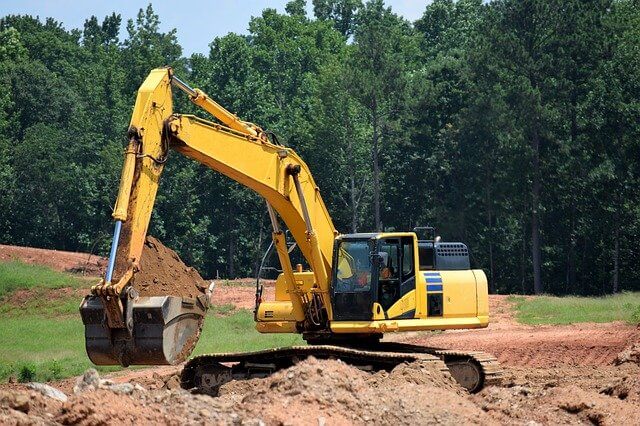
It consists of a bucket, stick, boom, and moving unit. The bucket is also known as a dipper, which consists of teeth at the end position. It has a drag cable and also a set of hoist line.
The output of this machine is somewhat similar to the power shovel. If the excavation is to be done near the machine, then it performs better than a power shovel, since the time of the cycle decreases.
Generally, the price of a Backhoe varies from $25,000 to $135,000. This depends on their size. The small-size backhoe price is around $25,000 to $48,000, and the larger-size of backhoe price is around $45,000 to $135,000. Read Also: 50 Construction Tools.
8. Dumper Truck
A dumper truck is nothing but a truck including automatic unloading devices. This is one of the most important construction machines from the transportation point of view.
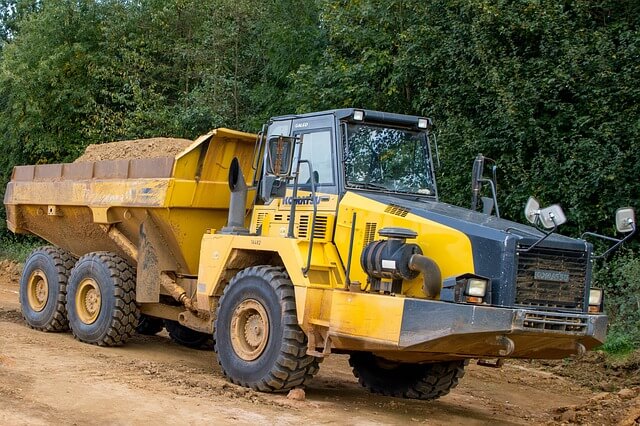
It is suitable for level as well as rough types of roads. This type of truck is very effective for work where time is a very important factor, as they have high speed and quick unloading facilitates.
In this type of truck, loading is done manually or by means of mechanically. But, unloading is done automatically with the help of a device that is fitted with the truck.
They are heavy-duty trucks with a strong body and are used for transporting construction materials like – boulders, murram, etc. Usually, the capacity of dumper trucks varies from 50 to 55 tonnes.
9. Road Roller
A road roller is compactor-type heavy construction equipment. It is mostly used to compact the soil, and other road materials such as the boulder layer, murum layer, sand layer, etc. Road rollers may be classified based on their weight in tons. In most cases, 10 to 15 tonnes weight rollers are commonly used.
Heavier rollers are used for compacting large size of boulder layers, or where their well compaction is an important factor. In the case of the loose soil layer, Rubber-tyred rollers are used to get a smooth finish of the wearing cote of the road.

10. Sheep Foot Roller
Sheep foot or pad foot roller is another heavy equipment used for construction works such as road construction, railroad construction, dam, and heavy building foundation works.
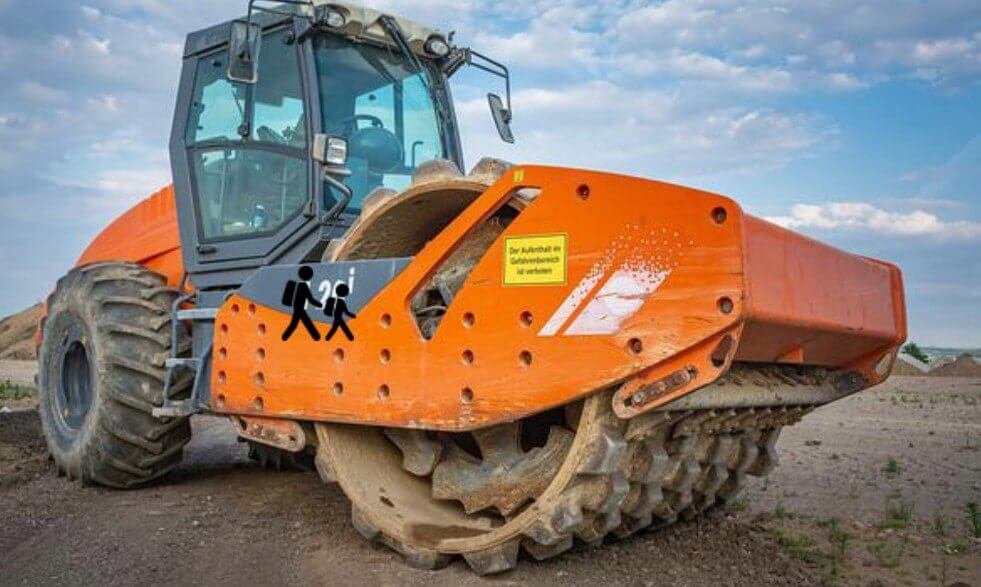
It is another type of roller consisting of a cylindrical steel drum with several small rectangular-shaped lungs on the outer surface. As these rectangular-shaped lungs are similar to the sheep’s foot, the rollers are called sheep foot rollers. Sheep foot rollers are usually driven by wheeled tractors. They can produce a high degree of compaction, therefore, it is suitable in such places where the compaction requirement is too high.
As it is compacting equipment, it is used to compact soil, not for all types of soil, but for silty & clayey sand, clayey silt, and heavy clay soil. Usually, this roller works at an average speed of 6 to 10 km per hour. The average price of a sheep foot roller is around $37,000.
11. Electric Overhead Crane
The electric overhead crane is also known as a bridge crane or EOT crane. This crane consists of parallel runways, and it creates a bridge between the two points. Generally, it is operated by electric power.
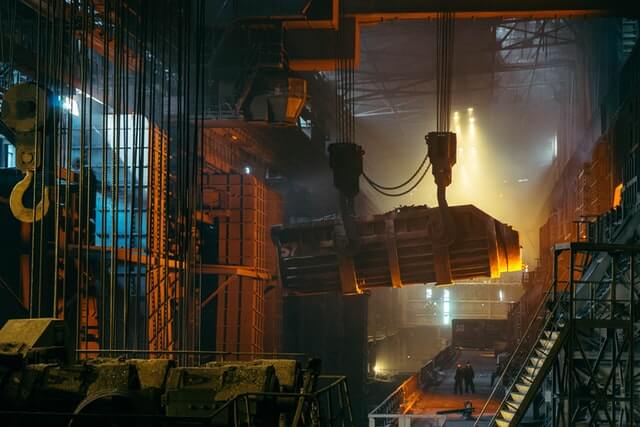
The main purpose of the electric overhead crane is to carry heavy or bulk loads from one end to the other end without interrupting the ground of that span.
It can lift and lower loads vertically, and convey loads horizontally through the overhead span. In 1876, the first electric overhead crane was introduced by Sampson Moore.
The capacities of the overhead cranes may vary from 1 tonne to 500 tonnes. The price of such types of cran varies on their capacity, lifting height, and also crane span.
12. Belt Conveyor
The belt conveyor system is one of the most reliable and easiest materials handling systems. The belt conveyor is typically used when huge volumes of materials need to be transported quickly over a long distance.
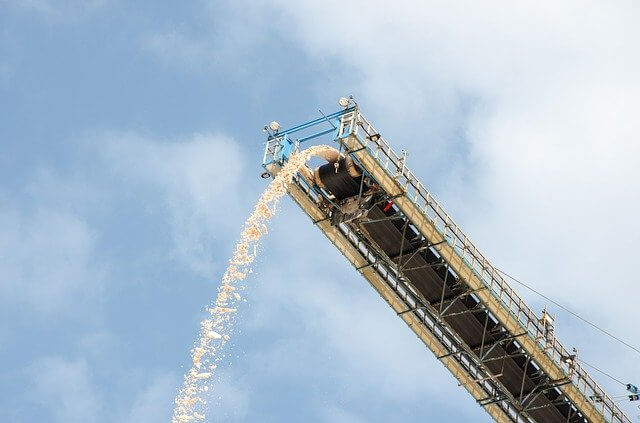
The system of belt conveyor consists of a belt running over a pair of end drums, and a series of rollers known as idlers support it at decent intervals. Belt Conveyors are durable and reliable equipment used in the automated transportation of materials.
13. Single Cable Rope Way
It is collectively known as a material handling system used to transport materials from one place to another. It is usually installed where it is difficult to transport materials at floor level. This is exhibited as a prominent system when you have to transport materials as well as men across rivers or valleys.

In a single ropeway system, there is an endless rope connected with both end towers and is supported along its length on a series of pully mounted on the intermediate towers. At the head of the tower, the rope is passed around the traction drum which is rooted by electric or diesel power.
15. Concrete Mixer
Concrete Mixer homogeneously combines cement, sand, gravel, and water to form concrete. A large amount of demand and hunger for the quality of concrete used in a project has justified the use of concrete mixers.
For best results, the amount of water supplied, the time of mixing, the proper ratio of ingredients, the speed of the mixing drum, etc. are essential factors. The gigantic drum where the magic happens revolves around 18-20 RPM and time is dependent on the volume.
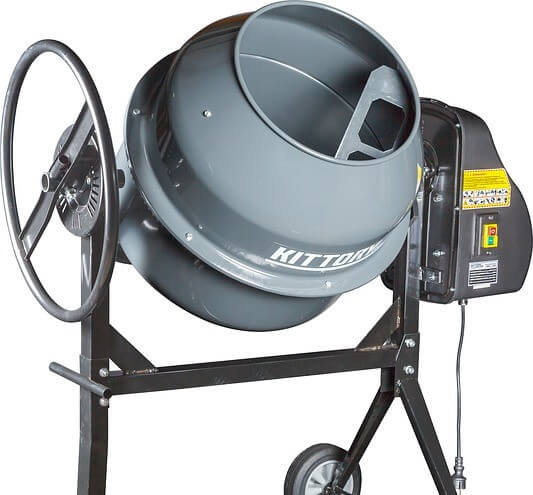
We may see some tilting or non-tilting mixers or some stationary or portable types fixed on some pair of wheels or on vehicles, but the basic work principle is exactly the same.
If we peep into history for just an instance, we can see an industrialist Gebhardt Jaeger inventing his concrete mixer on a fine evening while enjoying his evening coffee.
Today’s market has changed drastically since concrete mixers were invented back in the 1900s. Today’s market has a constant demand for consistent homogeneity and a short mixing time. If you are looking for high-intensity mixing in a rather short period of time, Twin-shaft mixers will do the heavy lifting for you in batches of 2-6 m3.
The most common mixer for pre-cast and pre-stressed concrete are vertical-axis mixers. They are used in small batches and have multiple discharge points. Lastly, Drum mixers are used for industrial-scale mixing where these mixers are capable of producing higher outputs.
The price of an ordinary concrete mixer is about $1,200 to $3,500, it is only preferable for small works. But in the case of large work, a huge capacity concrete mixer is used and the price of such types of concrete mixer may vary from $5,500 to $35,000 or even more.
16. Pump Crete
Pump Cretes or concrete pumps are one of the most important types of equipment used in construction. As the name suggests, Pump Crete is used to transfer concrete, which is freshly made and is in a liquid state, to the construction site.
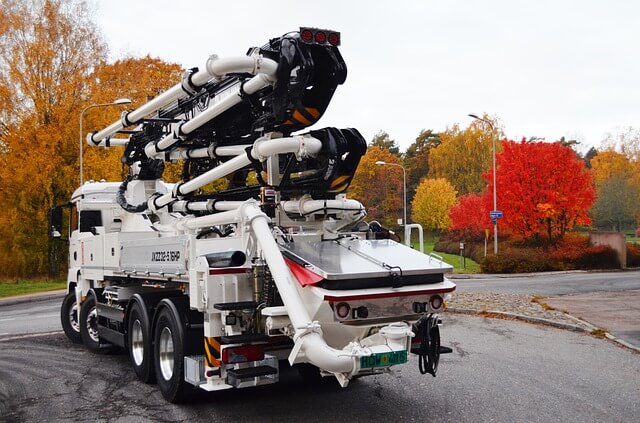
In traditional times, workers used to make round and round trips to pour the concrete which was a time-consuming and inefficient process. This waste of energy, time, and money was rescued by two German engineers, Max Giese, and Fritz Hull, who came up with the idea of pumping concrete through pipes in 1927.
Sadly concrete pump designers face many problems because concrete is viscous, heavy & abrasive, and solidifies if left stationary condition.
To overcome this problem piston pumps were designed because they can produce hundreds of atmospheric pressure. It is basically a reciprocating pump that has two valves; a suction and a discharge valve. The opening and closing of the valves are dependent on the piston movement.
Pump Crete is basically two types one is a line pump, and the other is a boom pump.
In the case of the line pump, it is used on the ground level and the concrete is pumped until it reaches its destination.
If you need direct action on the exact location, then the boom pump will be the best choice. It can extend its robotic arm which is controlled by the remote and can transfer the concrete where it needs to pour. It is also called truck mounted pump as they are usually mounted on the truck. The price of a boom pump may vary from $1,50000 to $3,50000 or even more.
17. Concrete Vibrator
After the concrete is poured, it needs to shake in a proper way so that there are no air bubbles left in the concrete. Vibrators are the most prominent equipment to fulfill this requirement. Vibrators are used to shake the concrete vigorously after its placement and remove all the possible air space.

People used hand tamping before vibrators were introduced but now hand tamping is almost everywhere replaced by vibrators. The vibrations are often created by using a motor and a drive shaft with an unbalanced mass.
The most commonly used vibrators are immersion vibrators or internal vibrators. They have a steel tube that is immersed in freshly laid concrete.
There is another type of vibrator called an external vibrator. It is used on the concrete form-work instead of direct concrete.
Internal vibrators are more effective than external vibrators. A vibrator must provide 3600 vibrations per minute for ideal compaction.
The price of a concrete vibrator may vary from $300 to $1,500. It depends on the capacity of the motor used in the vibrator.